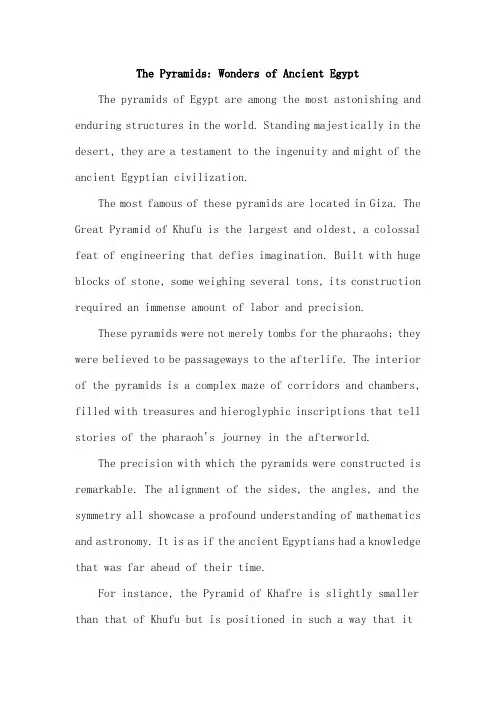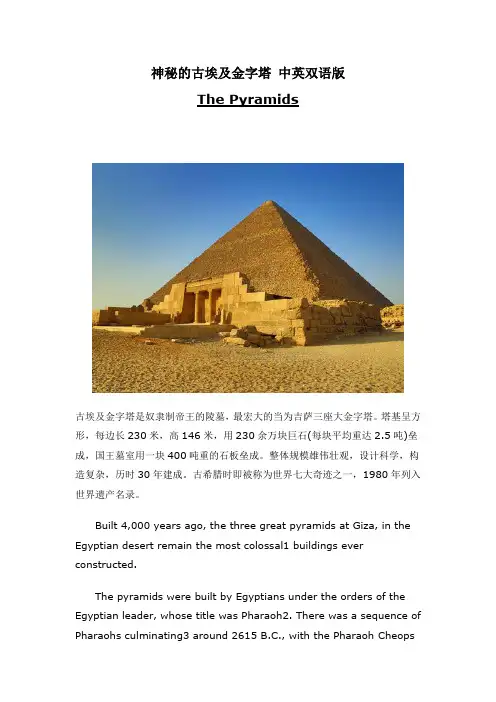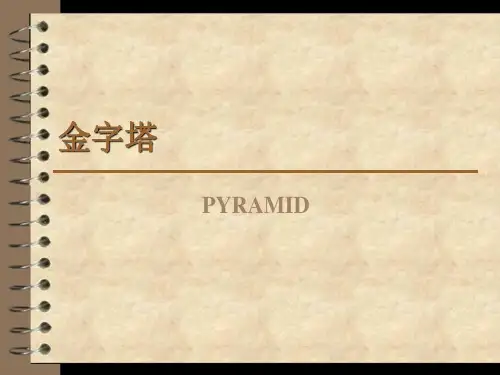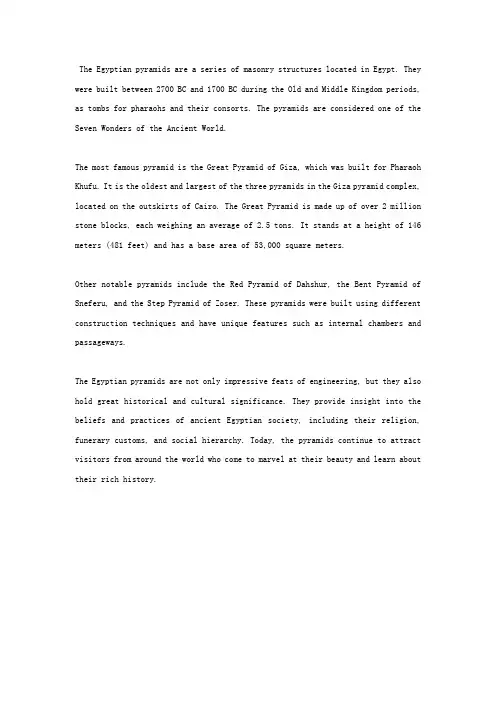金字塔未解之谜 英文介绍ppt
- 格式:ppt
- 大小:1.39 MB
- 文档页数:27






The Pyramids: Wonders of Ancient EgyptThe pyramids of Egypt are among the most astonishing and enduring structures in the world. Standing majestically in the desert, they are a testament to the ingenuity and might of the ancient Egyptian civilization.The most famous of these pyramids are located in Giza. The Great Pyramid of Khufu is the largest and oldest, a colossal feat of engineering that defies imagination. Built with huge blocks of stone, some weighing several tons, its construction required an immense amount of labor and precision.These pyramids were not merely tombs for the pharaohs; they were believed to be passageways to the afterlife. The interior of the pyramids is a complex maze of corridors and chambers, filled with treasures and hieroglyphic inscriptions that tell stories of the pharaoh's journey in the afterworld.The precision with which the pyramids were constructed is remarkable. The alignment of the sides, the angles, and the symmetry all showcase a profound understanding of mathematics and astronomy. It is as if the ancient Egyptians had a knowledge that was far ahead of their time.For instance, the Pyramid of Khafre is slightly smaller than that of Khufu but is positioned in such a way that itappears the same size when viewed from a certain distance. This demonstrates the meticulous planning and architectural genius of the builders.The pyramids have withstood the test of time, weathering centuries of sandstorms and the passage of history. They continue to draw millions of visitors from all corners of the globe, who come to marvel at these ancient wonders and ponder the mysteries they hold.In conclusion, the pyramids of Egypt are not just buildings; they are symbols of a bygone era, a source of endless fascination and a reminder of the greatness of human civilization.。

神秘的古埃及金字塔中英双语版The Pyramids古埃及金字塔是奴隶制帝王的陵墓,最宏大的当为吉萨三座大金字塔。
塔基呈方形,每边长230米,高146米,用230余万块巨石(每块平均重达2.5吨)垒成,国王墓室用一块400吨重的石板垒成。
整体规模雄伟壮观,设计科学,构造复杂,历时30年建成。
古希腊时即被称为世界七大奇迹之一,1980年列入世界遗产名录。
Built 4,000 years ago, the three great pyramids at Giza, in the Egyptian desert remain the most colossal1 buildings ever constructed.The pyramids were built by Egyptians under the orders of the Egyptian leader, whose title was Pharaoh2. There was a sequence of Pharaohs culminating3 around 2615 B.C., with the Pharaoh Cheopswho built the biggest thing ever built, the Great Pyramid, also known as Khu?fu. Cheops built a pyramid 770 feet on one side and 481 feet tall. How ancient builders managed to build these massive structures has never been fully answered but the effort clearly required brains and brawn4.Was there engineering genius involved? Yes, there was. For example, when you're putting the block right at the top, how are you going to lug5 a block of stone that weighs several tons 480 feet up a structure? How are you going to do it, and how are you going to do it without leaving scratches6 on all the rest of the structure? And how many people does it take to drag a block weighing several tons 480 feet up into the sky? Approximately, 2.3 million blocks of stone were cut, transported and assembled to create the Great Pyramid.The Pharaohs may have set out to build magnificent tombs for themselves, but in the end they created monuments to human potential. There's a universal message in the pyramids. The pyramids belong to Egypt, but the pyramids also belong to the world. That's why we can all identify the pyramids as an early monument of human greatness.For being a man?made wonder that has survived the sands of time1, the pyramids rise to the number two spot.矗立在埃及沙漠中吉萨的三座大金字塔建于4000年前,它们一直都是有史以来最宏大的建筑。

金字塔原理英文版The Pyramid Principle English Version。
The Pyramid Principle is a powerful tool for communication and problem-solving, originally developed by Barbara Minto at McKinsey & Company. This principle provides a structured way to organize and present information, making it easier for the audience to understand and absorb the key message.At the core of the Pyramid Principle is the idea that ideas should be presented in a logical order, with the most important points at the top of the pyramid. This means starting with the conclusion or recommendation first, followed by the supporting arguments, and then the details or evidence. By structuring information in this way, the audience can quickly grasp the main message and then delve into the supporting details as needed.One of the key benefits of the Pyramid Principle is its ability to streamline communication. By starting with the main point, the presenter can immediately capture the audience's attention and ensure that the key message is not buried within a mass of information. This is particularly important in business settings, where time is often limited and decisions need to be made quickly.In addition to improving communication, the Pyramid Principle also helps with problem-solving. By organizing information in a logical and structured way, it becomes easier to identify the root cause of a problem and develop effective solutions. This can be especially valuable in complex and ambiguous situations, where clarity and precision are essential.The Pyramid Principle is not only applicable to written documents and presentations, but also to verbal communication. Whether it's a formal presentation, a team meeting, or a one-on-one discussion, the principle can be used to ensure that ideas are communicated clearly and effectively.To apply the Pyramid Principle effectively, it's important to start by identifying the key message or recommendation. This forms the apex of the pyramid and serves as the guiding light for the rest of the communication. Once the main point is established, the supporting arguments can be developed, each building on the previous one to lead to the ultimate conclusion.In conclusion, the Pyramid Principle is a valuable tool for anyone involved in communication and problem-solving. By organizing information in a logical and structured way, it enables clear and effective communication, streamlines decision-making, and enhances problem-solving capabilities. Whether in a business setting or in everyday life, mastering the Pyramid Principle can greatly improve one's ability to convey ideas and make informed decisions.。



The Egyptian pyramids are a series of masonry structures located in Egypt. They were built between 2700 BC and 1700 BC during the Old and Middle Kingdom periods, as tombs for pharaohs and their consorts. The pyramids are considered one of the Seven Wonders of the Ancient World.The most famous pyramid is the Great Pyramid of Giza, which was built for Pharaoh Khufu. It is the oldest and largest of the three pyramids in the Giza pyramid complex, located on the outskirts of Cairo. The Great Pyramid is made up of over 2 million stone blocks, each weighing an average of 2.5 tons. It stands at a height of 146 meters (481 feet) and has a base area of 53,000 square meters.Other notable pyramids include the Red Pyramid of Dahshur, the Bent Pyramid of Sneferu, and the Step Pyramid of Zoser. These pyramids were built using different construction techniques and have unique features such as internal chambers and passageways.The Egyptian pyramids are not only impressive feats of engineering, but they also hold great historical and cultural significance. They provide insight into the beliefs and practices of ancient Egyptian society, including their religion, funerary customs, and social hierarchy. Today, the pyramids continue to attract visitors from around the world who come to marvel at their beauty and learn about their rich history.。
世界未解之谜金字塔作文英语Deep within the deserts of Egypt, stand the ancient monuments that have fascinated and baffled historians, archaeologists, and the general public alike for centuries. These structures, known as the pyramids, are not just monolithic tombs for ancient Egyptian royalty, but a testament to the engineering prowess and architectural genius of a civilization gone by.The largest among them, the Great Pyramid of Giza, stands as a monumental structure, visible from miles away. Constructed over a period of more than 20 years, it is estimated to have taken the efforts of tens of thousands of workers to complete. The pyramid's design is not just aesthetically pleasing but also mathematically precise, with each of its sides being almost perfectly aligned to the cardinal directions.What makes the pyramids truly mysterious, however, is not just their scale and precision but the secrets they seem to hold within their stone walls. Despite being studied and analysed for centuries, there are still many unanswered questions surrounding the constructiontechniques, purpose, and the exact methods used to align them with the cardinal directions.One of the most intriguing mysteries is the means by which the ancient Egyptians transported the巨大石块used in the construction of the pyramids. The blocks, weighing several tons each, were quarried from far-off locations and then transported to the construction site, often over distances of hundreds of miles. The question is, how did they move these巨石without the aid of modern machinery?Another mystery is the purpose of the pyramids themselves. While it is generally accepted that they were tombs for the ancient Egyptian royalty, their exactfunction and the role they played in Egyptian religion and society remain enigmatic. Some theories suggest that they were used as observatories or temples, while others believe that they were built to house the souls of the dead kings. The alignment of the pyramids with the cardinal directions is also a subject of much speculation. How did the ancient Egyptians, without the aid of modern technology, align the pyramids to within a fraction of a degree of accuracy? Some theories suggest that they used the sun andstars as guides, while others propose that they had a sophisticated understanding of geometry and trigonometry. Despite centuries of research and numerous theories, the mysteries surrounding the pyramids remain unresolved. However, it is this mystery that continues to fascinate people and spurs them to delve deeper into the past, seeking answers to the riddles posed by these ancient monuments.The pyramids of Egypt are not just structures of stone and mortar; they are symbols of human ingenuity and the boundless curiosity that drives us to explore and understand the unknown. As we continue to unravel the secrets of the pyramids, we also gain a deeper understanding of our own history and the capabilities of the human mind.**金字塔:世界未解之谜**在埃及的沙漠深处,矗立着几世纪以来一直令历史学家、考古学家和公众着迷和困惑的古老纪念碑。